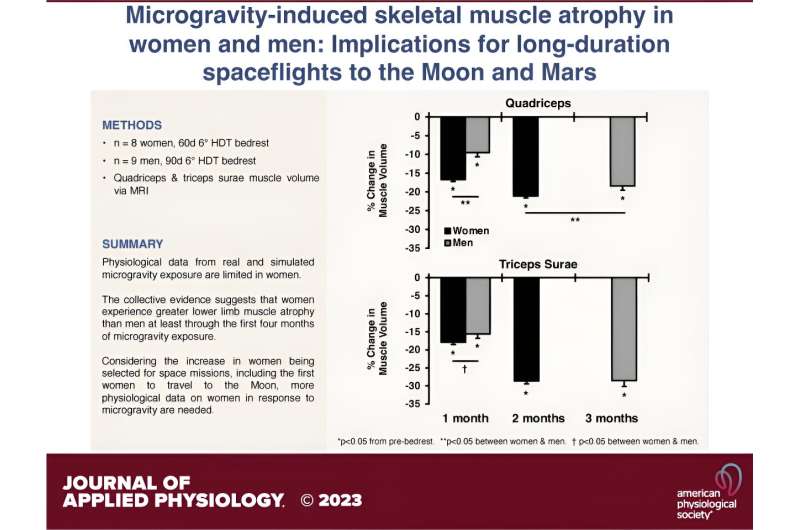This article has been reviewed according to Science X's editorial process and policies. Editors have highlighted the following attributes while ensuring the content's credibility:
fact-checked
peer-reviewed publication
trusted source
proofread
Research suggests women lose more muscle than men in spaceflight

New research published ahead of print in the Journal of Applied Physiology suggests women lose more muscle than men in a microgravity environment such as spaceflight. The study "represent[s] the longest bed rest study on a large cohort of women" and underscores the need for more sex-specific studies on physiological responses to microgravity, the research team wrote.
Historically, only about 2 out of every 10 astronauts sent into space have been women. With NASA's decision to diversify crewmembers in future spaceflight missions, including the agency's intention to send the first woman to the moon in 2024, scientists are more interested than ever in discovering how biological sex plays a role in the physiological response to microgravity. However, existing literature on the female response to low-gravity environments is sparse.
The current study explored muscle loss (atrophy) in men and women during two extended bed rest trials. The men spent 90 days, and the women spent 60 days in a 6-degree head-down tilt position, where their head was below their feet. This simulated a weightless condition similar to what crewmembers experience during spaceflight. Both volunteer groups ate, slept, performed personal hygiene, and all other activities in either the head-down tilt or a horizontal position.
The research team conducted magnetic resonance imaging tests on the volunteers' thigh and calf muscles before and after the trial as well as at the one-month mark of bed rest. These muscles were chosen "because they are critical for ambulation and extravehicular activities that likely will be required of space crews visiting the moon or Mars," the researchers said.
The researchers found that all participants lost a significant amount of muscle mass in both areas of the leg throughout their bed rest period compared to before bed rest. The women lost more muscle from the quadriceps at one month compared to the men, and the women lost more muscle mass at two months than the men lost at three months.
This trend is concerning not only because of the impact on typical muscle function but also because "it is now established that muscle serves as an endocrine organ, communicating with numerous other organs," the research team explained.
"The current findings from two spaceflight simulation studies suggest that women are more susceptible to weightlessness-induced muscle atrophy," the researchers wrote. "Therefore, a more appropriate path to understand sex-specific responses to microgravity (including the muscle atrophy issue) and to obtain data to better protect the health of future crewmembers may be through well-controlled long-duration bed rest studies with only exercise countermeasure groups."
The research team explained that they suggest this path because other studies have shown women to be very responsive to exercise countermeasures during (simulated) weightlessness. In addition, future space missions are likely to be much longer than the current study and information in this area is needed for longer durations of weightlessness.
More information: Todd A. Trappe et al, Microgravity-induced skeletal muscle atrophy in women and men: implications for long-duration spaceflights to the Moon and Mars, Journal of Applied Physiology (2023). DOI: 10.1152/japplphysiol.00412.2023
Journal information: Journal of Applied Physiology
Provided by American Physiological Society





















